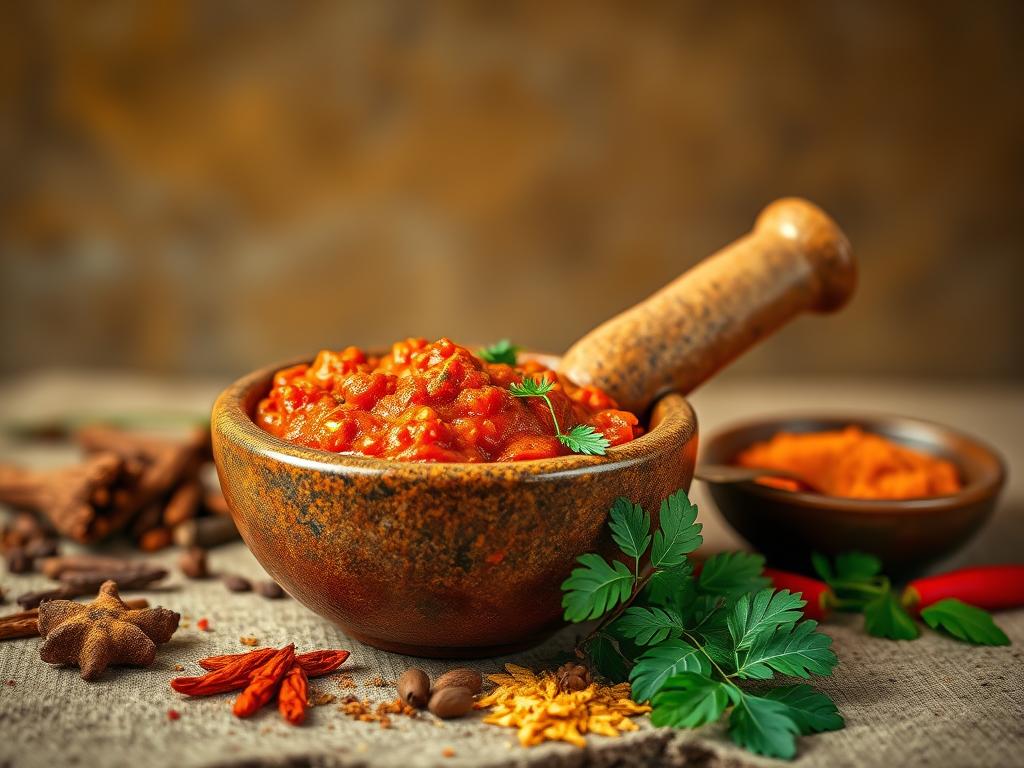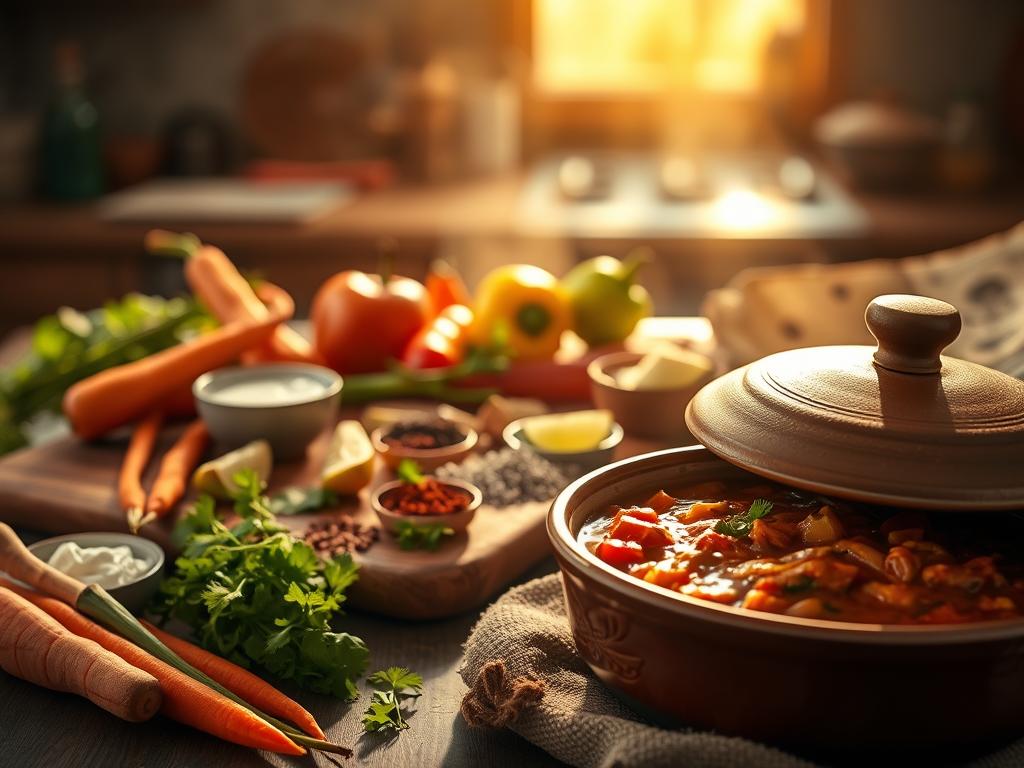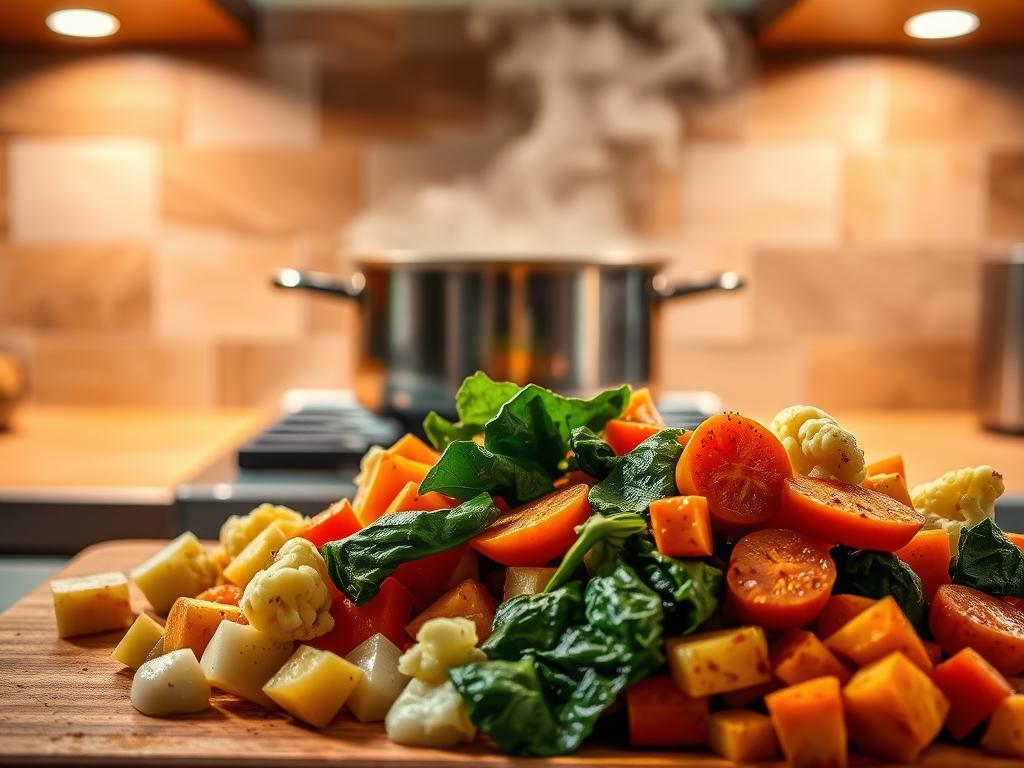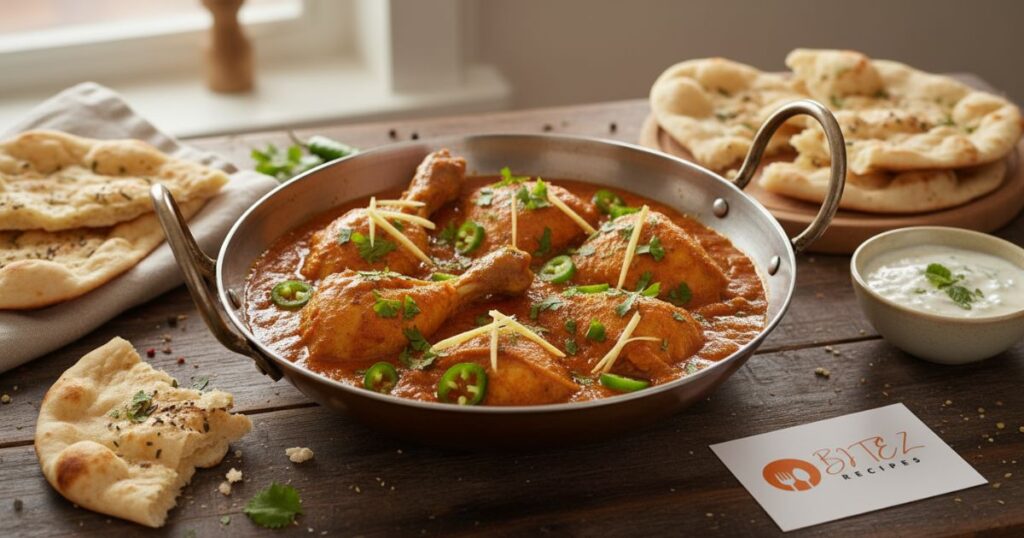
A delectable composition of colorful curried vegetables, elegantly set on a wooden table. Aromatic spices such as turmeric, cumin, and coriander fill the dish with a pungent bouquet. Bitez Recipes logo clearly visible, encapsulating the spirit of this savory culinary masterpiece. Soft, golden lighting creates a warm ambiance, inviting the observer to indulge in the appetizing scene. Delicately arranged to highlight the colorful palette of the simmered vegetables, such as carrots, potatoes, bell peppers, and onions. Shadows and textural information create depth,
while a simple, unobtrusive background maintains concentration on the main attraction – the luscious Curried Vegetables.
Curried vegetables mix roasted or sautéed veggies with warm spices like turmeric, cumin, and ginger. This vegetable curry recipe balances bold flavors and textures. It turns simple ingredients into a globally loved dish.
This guide shows how to make restaurant-quality curried vegetables at home. Whether you’re new to cooking or a seasoned chef, you’ll learn tricks. You’ll make vibrant, healthy meals using everyday pantry staples.
Key Takeaways
- Curried vegetables employ spices such as coriander and paprika for rich, savory flavor.
- Vegetable curry recipe instructions are simple to follow, even for beginners in the kitchen.
- Spice mixes differ by region, from mild to hot, to suit any taste.
- Packed with veggies and healthy fats, this meal increases nutrition and flavor.
- Make your curried vegetables your own with seasonal vegetables or pantry spices.
What Makes Curried Vegetables a Global Favorite
Curried vegetables are adored globally. They combine ancient traditions with fresh flavors. This indicates their timeless appeal. Let’s discover why they are adored by so many.
The Perfect Balance of Spices and Vegetables
The combination of spices and veggies in curry vegetable medley is the main point. Cumin and turmeric add richness to the spice mix. This combination makes every bite thrilling and warm.
Chefs attribute this blend to make the dish fantastic. It suits everyone, whether roasted or sautéed.
A Brief History of Vegetable Curries
Vegetable curries began in ancient India, more than 2,500 years ago. They traveled with trade to Asia and Europe. By the 1600s, indian curry dishes were popular in Britain.
As relationships with India evolved, curries emerged as a communal food. They unite cultures everywhere.
“Curry’s flexibility is its brilliance,” observed in a 2023 culinary research report, describing how recipes transformed to accommodate native palates from London to Los Angeles.
Why Americans Are Falling in Love with Curry Dishes
Americans are falling in love with curries in the United States. They’re healthy, full of vegetables and spices. Cookbooks and restaurants such as Spices of India in New York demonstrate how they’re incorporated into American cuisine.
They’re perfect for any meal, from everyday dinners to holidays. You can get anything from pre-made pastes to fresh ingredients. Curries satisfy many demands.
Curried vegetables are enjoyed for their flavor, memories, and health. Then we shall examine the key ingredients responsible for making them so special.
Key Ingredients for Delicious Curried Vegetables
Preparing delicious indian curried vegetables starts with the proper stuff. These ingredients blend to provide the food with a specific flavor and texture. Every spice and vegetable contributes to balancing the vegetarian curry’s texture and flavor.
“The right ingredients turn a simple dish into a celebration of flavor.” – Chef Priya Patel
- Spices: Turmeric, cumin, coriander, and garam masala are key in most vegetarian curry recipes.
- Aromatics: The base flavor comes from onions, garlic, and ginger.
- Vegetables: The classics are potatoes, cauliflower, and eggplant, but experiment with new vegetables too.
- Liquids: Coconut milk makes it rich, and tomatoes or broth thicken it.
| Spice | Role | Substitution |
|---|---|---|
| Turmeric | Color + earthy warmth | Paprika + black pepper |
| Cumin | Earthy foundation | Caraway seeds |
| Garam Masala | Complex spice blend | Combine cinnamon, cardamom, and cloves |
For the harder-to-find spices such as fresh curry leaves, try international markets or online retailers such as World Spice Merchants. Use the freshest ginger and garlic for best aroma. Begin with simple combinations, then experiment with new blends. Authenticity is all about balance, not perfection.
The Beginner’s Guide to the Best Curried Vegetables Recipe
Mastering easy curried vegetables is about learning the basics. This is an easy-to-follow guide to prepare tasty, delicious meals. Don’t worry if you are a beginner in cooking; it’s easy to follow.
Prep Work That Matters
Prepare your workspace professionally. Chop carrots, cauliflower, and bell peppers into the same cut for uniform cooking. Begin with 1 tsp of curry powder and add to taste.
Prepare a clean cutting board and sharp knife. Chopping vegetables becomes quicker and more secure this way.
Step-by-Step Cooking Instructions
- Place 1 tbsp oil in a pan over medium heat. Add 1 onion that has been diced and cook until translucent (3-4 minutes).
- Add 1 tsp curry powder and ½ tsp cumin. Stir for 1 minute until it’s fragrant.
- Add the vegetables and ¼ cup of water. Simmer covered for 10-12 minutes, stirring occasionally.
- Add salt and squeeze of lemon juice before serving.
Tuning Spice Levels to Your Taste
Hot stuff? Add a diced jalapeño or a spoonful of sriracha. Milder? Add a spoonful of coconut milk. Taste along the way. This is your simple curry recipe, so do it your way!
The Art of Making Your Own Curry Paste
Homemade curry paste makes vegetables taste like they were made in a high-end restaurant. It’s all about flavor. Making your own paste is the secret.

Bitez Recipes – A colorful, handmade curry paste presented in an earthy, country-inspired stage. Colorful red-orange paste with warm aromatics such as cumin, coriander, and turmeric, painstakingly blended using a classic mortar and pestle. Whole spices, fresh greenery, and chili peppers mottled all around, which speaks of home-style curry. Warm, diffused light from overhead emphasizes the color and texture, and a plain background lets the ingredients be the focus. The mood is one of authenticity, handcraft, and the homely scent of homemade curry.
Fresh vs. Store-Bought Curry Paste
Homemade curry paste is healthier and better-tasting than store-bought. Here’s why:
- Flavor: It contains bold, genuine flavors.
- Cost: It may be more expensive but is healthier.
- Customization: You can make it to your own specifications.
Regional Differences in Curry Paste
Experiment with flavors from across the globe:
- Thai: It’s spicy with lemongrass and chili.
- Indian: It’s rich with cumin and coriander.
- Malaysian: It’s savory with belacan (shrimp paste).
“A good curry paste begins with quality ingredients—don’t ever skimp on spices.” — Chef Priya Rao, Spice Kitchen Magazine
Tips for Storing Homemade Curry Paste
Store it fresh with these tips:
- Freeze in ice cube trays for convenient use.
- Keep in airtight containers in the refrigerator for two weeks.
- Use oil-packed storage to retard oxidation.
It is time-consuming but worthwhile to make homemade curry paste. Experiment with different styles and have it fresh. Your next curry will be great.
Health Gains from Spices in Your Vegetable Curry
Nutritious curried vegetables are not only delicious; they are also rich in nutrients. Spices such as turmeric, cumin, and ginger serve not only to give food its flavor. They also promote better health. Let’s observe how these foods transform veggies into a healthy dish.
- Turmeric: Rich in curcumin, which is anti-inflammatory.
- Cumin: Enhances digestion and iron uptake.
- Ginger: Alleviates nausea and sore muscles.
- Garlic: Enhances immunity and heart health.
| Spice | Health Benefit | Example Use |
|---|---|---|
| Turmeric | Anti-inflammatory | Golden milk or roasted veggie blends |
| Cumin | Digestive aid | Seasoning for roasted or sautéed dishes |
| Ginger | Antioxidant-rich | Added to soups or stir-fries |
Healthy curry meals can accommodate any diet. For heart health, include leafy greens and low-sodium broth. For blood sugar regulation, serve with fiber-rich lentils. A small amount of spice a day can enhance immunity and energy.
Use fresh or high-quality store-bought pastes for maximum benefits. When you cook next, keep in mind your curry is not just food. It’s a blend of flavor and wellness.
Shifting Your Curry: Vegetable Mixtures for Each Season

Bitez Recipes: A colorful still life of a seasonal vegetable curry, set in warm, golden light. In the foreground, a spicy, fragrant curry cooks in a clay pot, surrounded by a variety of fresh, colorful vegetables – carrots, bell peppers, and zucchini. In the middle distance, a wooden board holds a variety of spices, herbs, and accompaniments, including yogurt, naan, and lime wedges. The backdrop is softly blurred, brown-hued kitchen scenery, which suggests the homely warmth of a home meal. The tone is one of gastronomic wealth and celebration of seasonal, healthful ingredients.
Open up new vegetable curry inspiration through matching ingredients to the seasons. Let’s take a look at how to season your spicy vegetable curry to fit the freshest produce:
Spring and Summer: Light & Bright Flavors
Welcome crisp veggies during warmer times. Try:
- Zucchini and cherry tomatoes with coconut milk and fresh cilantro
- Grilled eggplant with bell peppers and a sprinkle of lime juice
- Asparagus tips stir-fried in a mildly spicy vegetable curry base
Fall and Winter: Warm Comfort Food
Replace warm root vegetables with cold weather. Choices are:
- Butternut squash with sweet potatoes and cumin seeds
- Kale and cauliflower cooked in a tomato sauce
- Potatoes and carrots with a smoky paprika mix
A seasonal guide to make your decisions easier:
| Season | Vegetables | Spice Pairings | Tip |
|---|---|---|---|
| Spring/Summer | Zucchini, asparagus, bell peppers | Cilantro, mint, turmeric | Use high-heat cooking for charred edges |
| Fall/Winter | Squash, kale, potatoes | Cumin, paprika, cinnamon | Slow-cook for deeper flavors |
Shop at local farmers’ markets to get the freshest choices. Add fresh chilies to increase the heat in any spicy vegetable curry.
From Side Dish to Main Event: Serving Your Curried Vegetables
Turn your spicy curry vegetables into the main event. Match them well and create a meal around them. This makes a simple dish a complete meal.
Perfect Pairings: What to Serve with Vegetable Curry
Here are a few traditional combinations to take your dish to the next level:
- Rice: Jasmine or basmati rice absorb curry flavors nicely.
- Bread: Soft naan or roti absorb the sauce.
- Cooling sides: Cucumber salad or raita of yogurt cool down the heat.
- Condiments: Cilantro or lime juice provide a fresh flavor.
Turning It into A Full Meal
Add protein sources such as chickpeas, tofu, or paneer for a complete meal. Vegetarians add eggs or feta. Vegans substitute lentils or jackfruit.
Serve large servings of curry with bread and grains. Attempt a vegan curry recipe paired with quinoa and sweet potatoes for a family dinner.
Use seasonal vegetables such as zucchini in the summer and cauliflower during winter. Serve 1½ cups of curry per individual. Include ½ cup rice and a slice of bread. For large gatherings, include lentil salad or grilled vegetables.
Troubleshooting Common Problems While Preparing Vegetable Curry
Even experienced chefs encounter problems during the process of vegetable curry recipe. Let’s address the most common setbacks to enable you to serve flawless curried vegetables all the time.

Bitez Recipes – a vibrant, richly textured vegetable curry dish set against a backdrop of a spotlit kitchen countertop. In the foreground, a variety of chopped vegetables – potatoes, carrots, cauliflower, and spinach – spill out of a wooden cutting board, ready to be simmered in a fragrant curry sauce. In the middle ground, a large saucepan simmers on a gas burner, steam rising and filling the air with the aroma of cumin, coriander, and turmeric. The lighting is warm and focused, casting dramatic shadows and highlights that accentuate the textures of the ingredients. The overall mood is one of culinary problem-solving, with the image providing visual guidance for troubleshooting common issues that can arise when preparing a delicious vegetable curry.
- Vegetables too mushy? Overcooking softens texture. Cut veggies uniformly and adjust cooking times—tender-crisp veggies like bell peppers need less time than potatoes.
- Sauce too thin? Add a slurry of cornstarch and water or coconut milk to thicken. Thin too-thick sauces with broth or water slowly.
- Spices taste raw? Saute them for longer periods in oil prior to adding veggies to allow blooms in flavor. Burnt spices? Toss and begin anew—add fresh herbs such as cilantro to save the batch.
- Flavor too bland or unbalanced? Taste while you cook. Add saltiness with soy sauce, acidity with lime juice, or sweetness with honey. Too spicy? Chill with yogurt or cream.
Preparing curries takes practice. A chef once said:
“Even a slightly imperfect curry can be a comfort food masterpiece—season to your taste!”
Timing is everything—multitask by prepping veggies before heating the oil. Keep in mind, most repairs are minor tweaks. Note your adjustments to perfect your curried vegetables through trial and error.
Vegan and Vegetarian Adaptations for Indian Curried Vegetables
It’s easy to make vegetarian curry vegan-friendly. These modifications keep meals satisfying and healthy. They prove that plant-based cuisine can be thrilling.
Older Indian curries tended to be dairy-free by nature—current adjustments simply revisit those origins.
Plant-Based Protein Additions
The following are some protein-packed choices:
- Chickpeas provide protein and texture. Cook them for 15 minutes to absorb flavor.
- Lentils thicken sauces automatically. Red lentils work well with creamy sauces.
- Firm tofu absorbs spices. Cut it into cubes and marinate in turmeric and cumin before cooking.
Dairy-Free Creamy Curry Techniques
Get richness from plants:
- Coconut milk adds body. Use full-fat canned milk for optimum flavor.
- Cashew cream: Soak cashews and blend with water for creamy foundation. Use 1/2 cup cashews + 1/4 cup water per serving.
- Plant-based yogurt substitutes (such as soy or almond) contribute tang. Add at the end for brightness.
These modifications turn any vegetarian curry a complete meal. Use these methods to make each morsel enjoyable.
Conclusion: Bringing Global Flavors to Your Kitchen Through Curried Vegetables
Curried vegetables turn home cooking into a world tour. Simple curry recipes allow anybody to create dishes packed with international spices and crunchy veggies. These dishes are not only fast, but they are healthy curry dishes.
They combine protein-filled legumes, crisp greens, and roots into each dish.
Curries fit any diet or taste. You can swap veggies or add coconut milk for cream. This keeps meals exciting and fresh.
The history of curries reveals they’ve always been adaptable. From the ancient spice routes to current kitchens.
Begin with an easy recipe and then experiment. Let your kitchen become a laboratory for adventure in flavor. With each meal, you connect with heritage and nourish your body and mind.
Your next lunch might be an Indian, Thai, or original flavor. Ingredients are at your fingertips—what will your curry tell the world?
FAQ
What are the best vegetables to use in a vegetable curry recipe?
Bell peppers, carrots, potatoes, peas, and spinach are great for curry. They hold their shape and absorb spice flavors nicely.
How do I spice up curried vegetables?
Put in fresh chili peppers, red pepper flakes, or cayenne pepper for heat. Homemade curry paste with strong spices also increases heat.
Is there a vegan curry recipe for curried vegetables?
Yes! Substitute coconut milk for dairy-free creaminess. Add other vegetables and plant proteins such as chickpeas or tofu for a satisfying meal.
What is the nutritional content of curried vegetables?
Curried vegetables are packed with vitamins and minerals. The addition of spices such as turmeric provides extra health benefits, so curry is both delicious and healthy.
May I make curry vegetable medley ahead of time?
Yes! Precook the curry and refrigerate for up to three days. Reheat for a speedy meal.
How do I store leftover vegetable curry?
Let the curry cool, then transfer it to an airtight container. Refrigerate for up to three days or freeze for three months. Reheat thoroughly before consumption.
What can I serve with my curried vegetables?
Serve over rice or Indian breads such as naan or roti. A chilled side such as raita balances the heat.
May I make curry paste from scratch?
Absolutely! Homemade curry paste is simple and intensified flavor when you do it yourself. Puree ginger, garlic, turmeric, and chili for a bright foundation.
What are simple curry recipes for beginners?
Begin with simple vegetable curry using store-bought curry paste and coconut milk. It’s easy and delicious!
How do I adjust the spice levels in my vegetable curry?
Use less spice and add more to taste. Add sweetness with honey or sugar, or more vegetables to offset heat.








